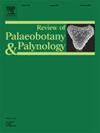Introduction to the special issue: Pollen diversity, vegetation history and range shift in the (sub)tropics through the Cenozoic
IF 1.7
3区 地球科学
Q2 PALEONTOLOGY
引用次数: 0
Abstract
Fossil pollen records are valuable for reconstructing past floristic composition, vegetation and biogeographic history. In recent decades, a deeper understanding of plant diversity throughout the Cenozoic has been achieved, significantly due to improved taxonomic resolution of palynological data, particularly in the (sub)tropics, where pollen diversity is notably high. Particularly, the development of pollen databases and innovative techniques in systematic palynology has shed further light on our understanding of pollen diversity, vegetation history and range shift in the past, as well as the factors driving these changes. This special issue compiles the latest studies on 1) systematic palynology, highlighting updated methodologies such as high-resolution microscopy, machine learning, and chemotaxonomy, 2) long-term vegetation history and 3) spatio-temporal range shift mainly focusing on the (sub)tropics, encompassing change rate of dynamic vegetation in global or regional scales, human impacts, range shift of ecologically-important tree taxa through the Cenozoic based on fossil pollen records and/or molecular data.
This special issue features fourteen papers that explore pollen diversity, vegetation history and range shift in the (sub)tropics throughout the Cenozoic, categorized into five areas: (1) Pollen diversity: ranging from traditional morphological studies to chemical analyses of sporopollenin and applications of machine learning; (2) Outreach and education initiatives involving 3D printing of pollen grains; (3) Applications of fossil pollen records: including their significance for reconstructing palaeoclimate, palaeobiogeography and palynostratigraphy; (4) Challenges in pollen counting within Quaternary pollen analysis; and (5) Vegetation history and plant range shift. Future palynological studies should further focus on chemonotaxonomy, sedimentary ancient DNA (sedaDNA), and the application of machine leaning to both modern and fossil pollen analyses.
求助全文
约1分钟内获得全文
求助全文
来源期刊
CiteScore
3.50
自引率
21.10%
发文量
149
审稿时长
6 months
期刊介绍:
The Review of Palaeobotany and Palynology is an international journal for articles in all fields of palaeobotany and palynology dealing with all groups, ranging from marine palynomorphs to higher land plants. Original contributions and comprehensive review papers should appeal to an international audience. Typical topics include but are not restricted to systematics, evolution, palaeobiology, palaeoecology, biostratigraphy, biochronology, palaeoclimatology, paleogeography, taphonomy, palaeoenvironmental reconstructions, vegetation history, and practical applications of palaeobotany and palynology, e.g. in coal and petroleum geology and archaeology. The journal especially encourages the publication of articles in which palaeobotany and palynology are applied for solving fundamental geological and biological problems as well as innovative and interdisciplinary approaches.

 求助内容:
求助内容: 应助结果提醒方式:
应助结果提醒方式:


